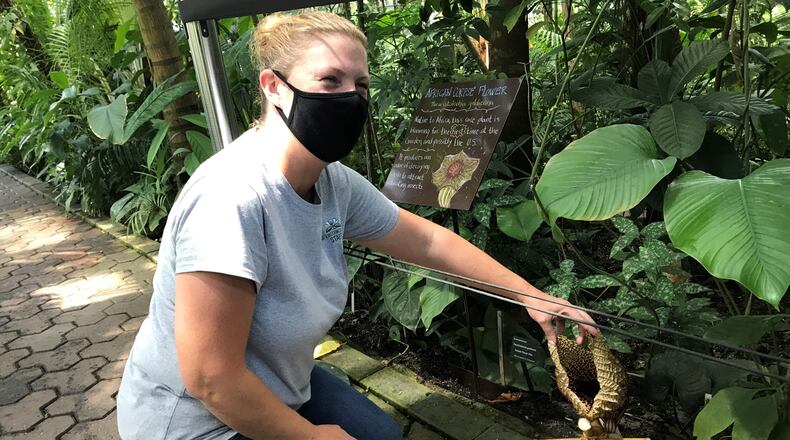Entering the Fuqua Conservatory at the Atlanta Botanical Garden on Thursday, Midtown resident and garden member Jade Jamrozy was informed that she would have a once-in-a-lifetime opportunity to see a rare African flower that smells like rotting flesh.
”What a blessing,” she said, not altogether convincingly.
Yes, it stinks, but Atlanta’s grotesque new blossom is also distinctive. It is apparently the first time the rare plant has flowered in a garden in the North American continent.
“If you see this flower you will be among the few people in the world who have seen it,” said Paul Blackmore, manager of the Fuqua, who planted the vine in 2018 and carefully nurtured the Pararistolochia goldieana to adulthood.
“I’ve only seen it once before. The nearest thing I can compare it to is a rat trapped under the floorboards,” he said of the Pararistolochia’s unique aroma. “It smells like a pile of dead bodies.”
The striated cream-and-crimson flower is fleshy and huge, and sits near the ground, immediately next to the pathway that carries visitors through the conservatory.
Credit: Atlanta Botanical Garden
Credit: Atlanta Botanical Garden
Native to central Africa, it grows on a runner, like black pepper, and can be found in Cameroon, Equatorial Guinea, Nigeria and Sierra Leone.
It made its way to Atlanta courtesy of Alex Eilts, an ecologist and research associate at the University of Minnesota’s College of Biological Sciences, who secured some seeds from a mature plant and germinated them into seedlings.
Eilts then traded some of his tiny plants with a group of large botanical gardens, including gardens in Florida, Missouri and Atlanta. He gave the gardens an informal challenge to see which one could produce a blossom first.
“It’s a big, showy, smelly impressive flower, and no one to my knowledge has seen it before at a garden in North America,” he told Atlanta’s gardeners. “You guys have really done something there!”
Despite the fact that it is Africa’s largest blossom, “It’s on a really rather delicate vine,” said Amanda Bennett, the garden’s vice president of horticulture and collections.
The African corpse flower uses a survival strategy that is also native to a variety of other plants. By smelling like rotting meat, it attracts flies and other insects who then help to pollinate the blossoms.
The Atlanta Botanical Garden has famously coaxed a specimen of the enormous “stinky plant” Amorphophallus titanum to bloom, something that might not happen but once every seven to ten years.
The garden is also home to a species of orchid and some voodoo lilies that emit the same charming fragrance.
“They use the same terpenes, the same cocktail of compounds that attracts animals that are looking for something that’s roadkill dead,” said Blackmore.
Blackmore was working elsewhere in the garden when the blossom appeared, growing near the ground and bearing a pallid, paper bag color.
A volunteer saw it Monday and thought it was a piece of trash until she looked more closely.
Blackmore, a native of Brighton, England, worked for almost 10 years in a botanical garden on the slopes of an active volcano in Cameroon and saw the very same plant in its native habitat over there.
“I’ve seen it before, but never smelled it before,” he said.
Credit: Atlanta Botanical Garden
Credit: Atlanta Botanical Garden
The aroma surrounding Atlanta’s Pararistolochia had begun to taper off Thursday. By the time Jamrozy sniffed it, it was hardly objectionable, which might mean the blossom will soon wither and fall.
If the pollinators have done their work, then the withered blossom will produce a seed pod, which might produce seeds that could help other gardens propagate the rare plant.
Currently, the plant is behind a pair of stanchions at the Fuqua Conservatory, but accessible to the eyes (and noses) of visitors. Mick Erickson, a tropical horticulturalist at the Midtown garden, said Blackmore, who is taking a few days off, has politely suggested that some staffer station themselves next to the corpse flower to make sure nothing dire happens to it.
“My greatest fear,” said Blackmore, “is that some kid will pick it.”
About the Author
The Latest
Featured




